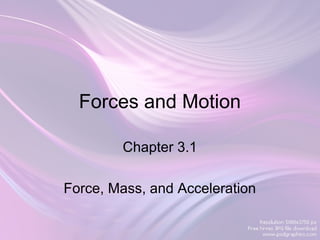
Forces and motion ch3.1
- 1. Forces and Motion Chapter 3.1 Force, Mass, and Acceleration
- 3. *Newton’s Laws of Motion • *First Law: An object at rest will stay at rest unless acted on by an unbalanced force. An object in motion will continue with constant speed and direction, unless acted on by an unbalanced force. • Second Law: Force causes an object to accelerate while the object’s mass resists acceleration. • Third Law: For every action, there is an equal and opposite reaction.
- 4. How would you move a heavy box?
- 5. Force • Since every object in a state of rest will stay at rest- you need to apply force to cause motion. • *What is force? – *Force is any action that has the ability to change motion • Example: Push or Pull
- 6. How do we measure force? • *There are two units of measurements of force: • *Pounds • *Newtons – 1 newton = 0.228 pounds – 1 pound = 4.448 newtons – A person who weighs 100 pounds would weigh 444.8 newtons.
- 7. Difference Between Force and Mass • A Force is a push or pulling action that causes change in motion • *Mass- is the amount of “stuff” in an object. – *Mass resists the action of forces making objects harder to move.
- 8. What is the difference between mass and weight? • *Weight is the amount of force pulling on an object due to gravity. • Mass is the amount of matter in an object. • Example: A child weighs 30 pounds on Earth with a mass of 14 kilograms. In space the child weighs only 4 pounds, but still has a mass of 14 kilograms. Why??
- 9. Mass and Inertia • *Newton’s First Law of motion is also called the Law of Inertia. • *Inertia is the property of an object to resist changing its state of motion. An object with a lot of inertia takes a lot of force to start or stop.
- 10. Answer these review questions in your own words: 1. *What is an example of force? 2. *What is a newton? 3. *What is the difference between weight and mass? 4. *What is inertia? 5. *Which is easier to get moving, a basketball or a bowling ball? Which is easier to stop? Why?
- 11. Part 2: Remember the Law of Inertia:
- 12. Law of Inertia • *First Law of Motion: An object at rest will stay at rest unless acted on by an unbalanced force. An object in motion will continue with constant speed and direction, unless acted on by an unbalanced force.
- 13. *What is this unbalanced force that acts on an object in motion? • *There are four main types of friction: – *Sliding friction: two surfaces rub against each other – *Rolling friction: object rolling over another – *Viscous friction (air or liquid): air or water resistance – *Air friction: air moving around an object creates opposing force
- 14. Friction • Objects on earth, unlike the frictionless space the moon travels through, are under the influence of friction.
- 16. Newton’s Laws of Motion • First Law: An object at rest will stay at rest unless acted on by an unbalanced force. An object in motion will continue with constant speed and direction, unless acted on by an unbalanced force. • *Second Law of Motion: Force causes an object to accelerate while the object’s mass resists acceleration. • Third Law: For every action, there is an equal and opposite reaction.
- 17. Newton’s Second Law • A force causes an object to accelerate, while an object’s mass resists acceleration. – Force causes acceleration – Mass resists acceleration – The acceleration you get is equal to the ratio of force over mass a=F/m a=acceleration F=force m=mass
- 18. What if?? http://www.physicsclassroom.com/mmedia/newtlaws/efar.cfm http://www.physicsclassroom.com/mmedia/newtlaws/efff.cfm • You drop an elephant and a feather at the same time off a building. Which will land first? No animals were harmed in the making of this PowerPoint!
- 20. They land at the same time? http://www.physicsclassroom.com/mmedia/newtlaws/efff.cfm
- 21. What happened?? • The feather reached its terminal velocity first- in other words: the feather was slowed down by the upward push of air resistance. Also called: air friction. • Since the elephant has so much more mass, it needed much more air to slow it down and reach it’s terminal velocity. There wasn’t enough time, so the elephant continued to gain speed until he landed.
- 22. What about gravity? • Gravity worked on both the elephant and the feather. • The pull of gravity was GREATER on the elephant, but the mass is also greater. • The increased mass resists acceleration at the same rate as gravity pulls it. • They cancel each other out- and the elephant falls at the same speed as the feather! (In a world with no air)
- 23. So… • Force causes an object to accelerate, while an object’s mass resists acceleration. • In a world with NO AIR, therefore NO friction- everything falls at the same rate! • But we will notice in our world, friction plays a big part in the rate of objects falling!
- 24. Newton’s Third Law: • *Newton’s Third Law of Motion: – For every action, there is an equal and opposite reaction.
- 25. What does it mean? • As you sit on your chair- you exert pressure on your chair, but your chair pushes back equally with pressure on you. • Action-Reaction Pair of Forces
- 26. Short Video
